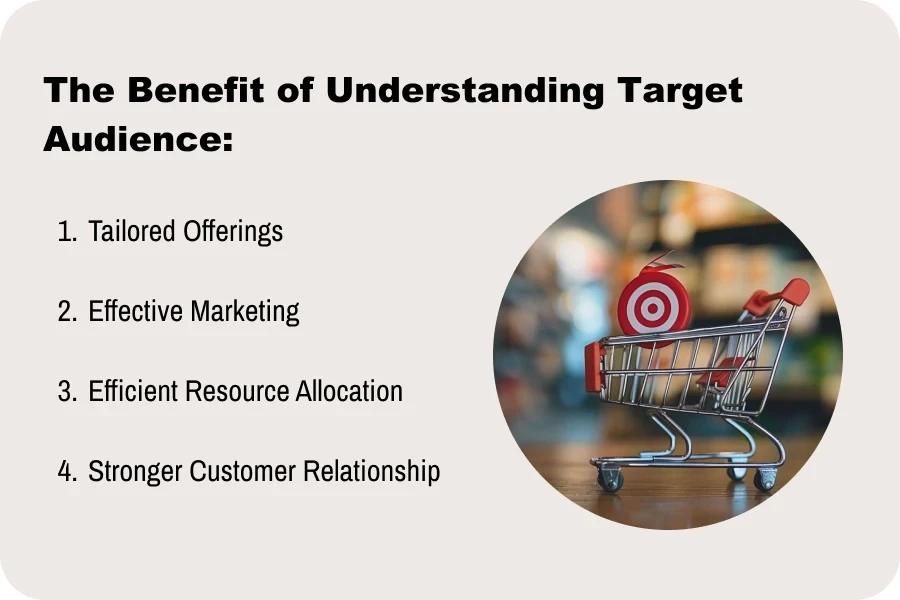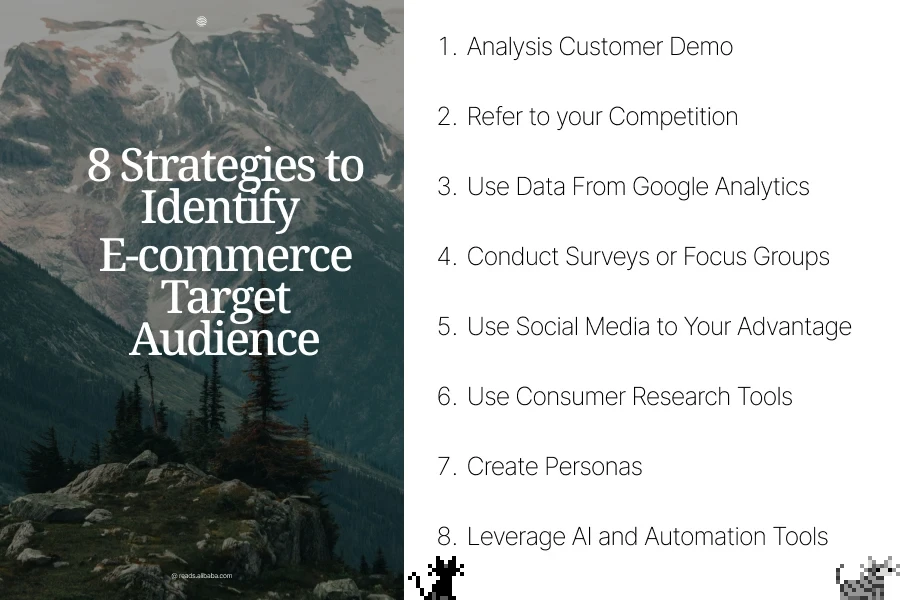Determining the target audience is crucial in e-commerce. Knowing who your ideal customers are allows you to tailor your marketing strategies and products to meet their specific needs and preferences, resulting in higher engagement and sales. This blog will discuss the importance of identifying your e-commerce target audience and introduce eight effective ways to do so. By understanding and implementing these methods, you can create a more personalized shopping experience that resonates with your audience and drives business growth.
Table of Contents
Defining Your E-commerce Target Audience
The Importance of Identifying Your Target Audience
The Stunning 8 Methods!💐
Defining Your E-commerce Target Audience
A target audience in e-commerce refers to the specific group of consumers you aim to reach with your products and marketing efforts. This group is characterized by shared traits such as demographics, interests, behaviors, and needs. For example, your target audience might include “women aged 25-40 who are interested in sustainable fashion” or “tech-savvy millennials looking for the latest gadgets.”

Defining your target audience is essential because it allows you to focus your resources on attracting the people most likely to buy your products. Instead of trying to appeal to everyone, you can create more tailored and effective marketing messages that resonate with your specific audience segments. By understanding who your ideal customers are, you can better anticipate their needs, create products they will love, and develop marketing campaigns that speak directly to them.

Identifying your target audience involves collecting and analyzing data to create detailed customer profiles. These profiles, often called personas, represent the different segments of your audience and help you visualize their preferences, motivations, and purchasing behavior. By honing in on your target audience, you can create a more personalized and engaging shopping experience that drives customer loyalty and boosts sales.
The Importance of Identifying Your Target Audience
Identifying and understanding your e-commerce target audience is crucial for several reasons.

This part of this Blog breaks down 4 reasons why understanding your e-commerce target audience is important:
Firstly, it enables you to tailor your products and services to meet the specific needs and preferences of your customers. This customization increases the likelihood of customer satisfaction and repeat purchases, as customers feel that your offerings are designed with them in mind.
Secondly, knowing your target audience allows you to create more effective marketing strategies. By focusing your efforts on the channels and messages that resonate most with your audience, you can improve your marketing ROI. For instance, if your target audience is highly active on social media, investing in social media marketing and influencer collaborations can yield better results than traditional advertising methods.
Additionally, a well-defined target audience helps you allocate your resources more efficiently. Instead of wasting time and money trying to appeal to a broad and undefined group, you can concentrate your efforts on the segments that are most likely to convert. This targeted approach leads to better resource management and higher profitability.

Furthermore, understanding your target audience fosters stronger customer relationships. By consistently addressing their needs and preferences, you build trust and loyalty, which are essential for long-term success. Loyal customers are more likely to become brand advocates, spreading positive word-of-mouth and attracting new customers to your store.
In summary, identifying your e-commerce target audience is vital for creating tailored products, crafting effective marketing strategies, managing resources efficiently, and building lasting customer relationships. These benefits collectively enhance your ability to achieve sustained growth and success in the competitive e-commerce landscape.
The Stunning 8 Methods! 💐
1. Analyze Customer Demographics and Psychographics
Start by examining the demographic and psychographic characteristics of your potential customers. Demographics include age, gender, income, education, and location, while psychographics delve into lifestyle, interests, values, and behaviors. For example, if you’re selling fitness equipment, you might target health-conscious individuals aged 25-45 who regularly engage in physical activities. By understanding these attributes, you can create more targeted and relevant marketing messages that resonate with specific audience segments.
2. Refer to Your Competition
Analyzing your competitors can provide valuable insights into your target audience. Look at who your competitors are targeting and how they are engaging with their audience. Examine their marketing campaigns, social media interactions, and customer reviews. By understanding what works for your competitors, you can identify potential gaps in the market and opportunities to differentiate your brand. This approach allows you to refine your own strategies and better cater to your audience’s needs.

3. Use Data From Google Analytics
Google Analytics is a powerful tool that provides detailed insights into your website visitors. It helps you understand who is visiting your site, what pages they are viewing, and how long they stay. You can also see which devices and browsers they use, their geographic locations, and the keywords they searched for. This data helps you identify patterns and preferences, enabling you to tailor your content and marketing efforts to better meet the needs of your target audience.
4. Conduct Surveys or Focus Groups
Direct feedback from your current and potential customers is invaluable. Conduct surveys or focus groups to gather insights into their shopping habits, preferences, and pain points. Ask questions about their interests, what products they are looking for, and what factors influence their purchasing decisions. This firsthand information helps you understand your audience’s needs and expectations, allowing you to make informed decisions about product development and marketing strategies.

5. Use Social Media to Your Advantage
Social media platforms are a treasure trove of information about your audience. Analyze your followers’ demographics, interests, and engagement patterns on platforms like Facebook, Instagram, and Twitter. Monitor the comments, likes, and shares on your posts to see what content resonates most with your audience. Additionally, use social media listening tools to track conversations about your brand and industry. This real-time data helps you stay connected with your audience and adapt your strategies to meet their evolving needs.
6. Use Consumer Research Tools
Consumer research tools, such as Google Trends, Facebook Audience Insights, and Pinterest Business Insights, provide valuable data about your audience’s behaviors and preferences. These tools help you identify trending topics, popular search terms, and audience interests. For example, Google Trends shows you how often specific search terms are used and where they are most popular. Facebook Audience Insights provides detailed demographic and behavioral data about your Facebook audience. Using these tools, you can make data-driven decisions to enhance your marketing strategies.

7. Create Personas
Creating detailed customer personas helps you visualize and understand the different segments of your audience. A persona is a fictional representation of a typical customer, complete with demographics, interests, and behaviors. For instance, you might create a persona for “Fitness Fanatic Fiona,” a 30-year-old woman who regularly attends gym classes, follows health influencers, and prefers high-quality fitness gear. By developing personas, you can tailor your marketing messages and product offerings to meet the specific needs of each segment.
8. Leverage AI and Automation Tools
AI and automation tools can streamline the process of identifying and targeting your audience. Tools like ConvertedIn use AI to gather shopper insights, create detailed personas, and automate targeted ad campaigns across multiple platforms. These tools analyze vast amounts of data to provide actionable insights, helping you make more informed decisions and optimize your marketing efforts. By leveraging AI and automation, you can enhance your ability to reach and engage your ideal customers more effectively.
Conclusion
Understanding and identifying your e-commerce target audience is essential for creating a successful online store. By knowing who your ideal customers are, you can tailor your products, marketing strategies, and overall customer experience to meet their specific needs and preferences. The eight methods discussed—analyzing demographics and psychographics, learning from competitors, leveraging Google Analytics, conducting surveys and focus groups, using social media insights, utilizing consumer research tools, creating personas, and employing AI and automation tools—provide a comprehensive approach to pinpointing your audience. Implementing these strategies will not only help you attract the right customers but also build stronger, more lasting relationships with them. Continuously refining your understanding of your audience ensures that you stay relevant and competitive in the ever-evolving e-commerce landscape.



